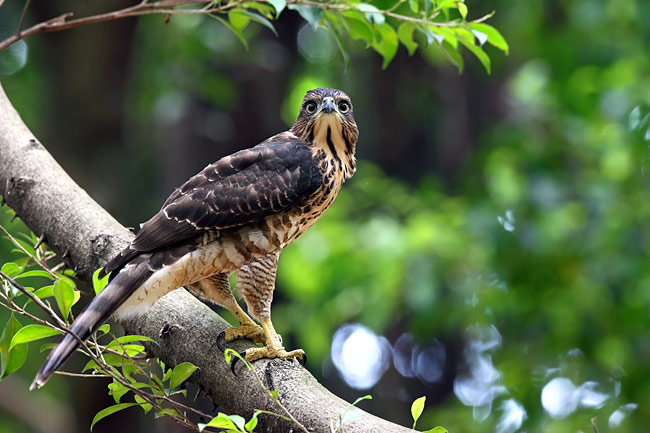200 species found near power plant
Writer: Zhang Yu | Editor: Holly Wang | From: | Updated: 2019-06-06
 Ho
Ho
An accipiter trivirgatus. File photo
More than 200 animal and plant species have been found in the vicinity of Daya Bay Nuclear Power Base, including eight species of State-level key protected animals and plants on land and seven species of stone corals that fall under State protection in the surrounding sea areas, the Shenzhen Special Zone Daily reported.
The discovery was based on a 15-year observation conducted by volunteers and a recent study on the biodiversity of the nuclear power base and its surrounding sea areas carried out by a group of 20 people.
The group consisted of online celebrities, well-known science fiction writers, members of environmental protection organization “Dive for Love” and public representatives.
It has been found that there is an abundance of wildlife on the 10 square kilometers of land around the nuclear power base, while the 11-kilometer coastline provides a safe haven for corals.
The eight national key protected animals and plants found on land are calotes versicolor, egret, bubulcus ibis, accipiter trivirgatus, buteo, otus ballamoena, python and mucuna birdwoodiana tutcher.
Bai Xiaoci, director of “Dive for Love” as well as Shenzhen Marine Library, said a survey on Dapeng Peninsula conducted in the 1980s showed that the coral coverage rate was over 70 percent. However, with the city’s rapid development, the coral coverage rate had dropped to around 30 percent in recent years.
A recent dive organized by “Dive for Love” found that the corals in the sea areas of the nuclear power base are in good condition.
“Dive for Love,” with a mission to rebuild the colorful underwater world, has been dedicated to marine coral conservation in Dapeng New Area since 2012.
According to Xia Jiaxiang, general secretary of “Dive for Love,” the organization has only five full-time staff, but has more than 2,600 registered volunteers. It regularly organizes activities such as diving in the sea to plant corals and giving lectures to popularize marine knowledge.
So far, the staff and volunteers of “Dive for Love” have planted more than 5,800 corals, bred nearly 200 broken coral branches and cleared 1,228 kilograms of marine garbage and more than 1,500 meters of fishing nets off waters.